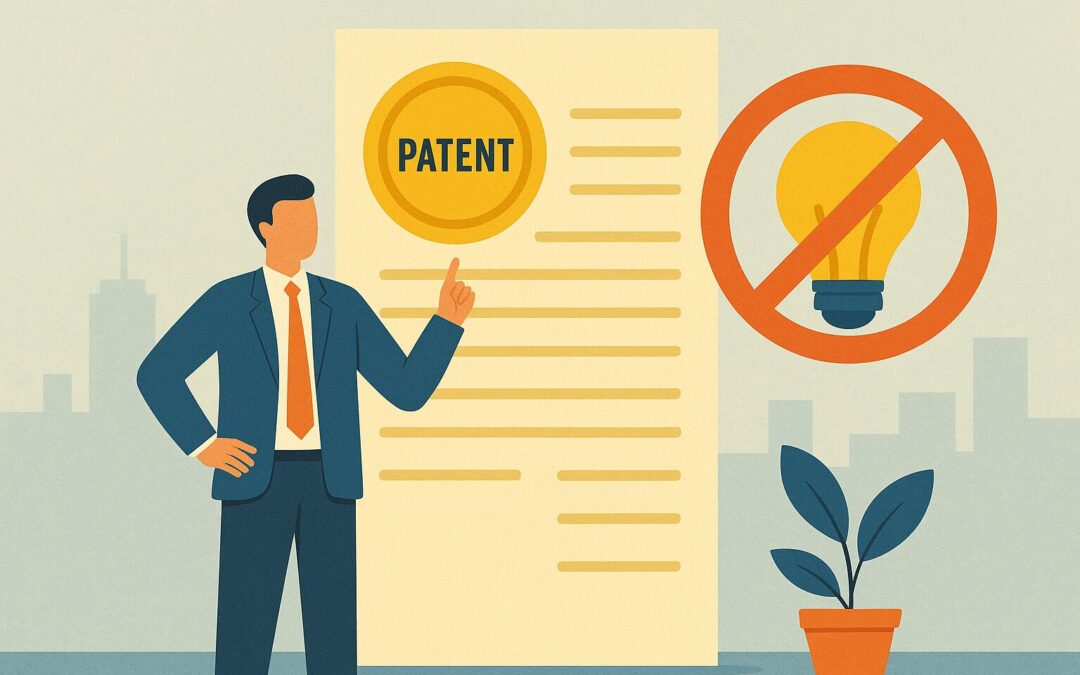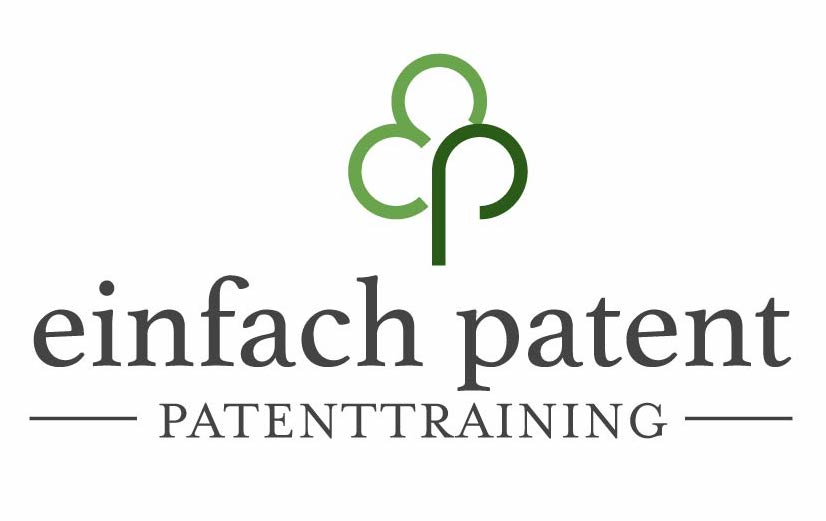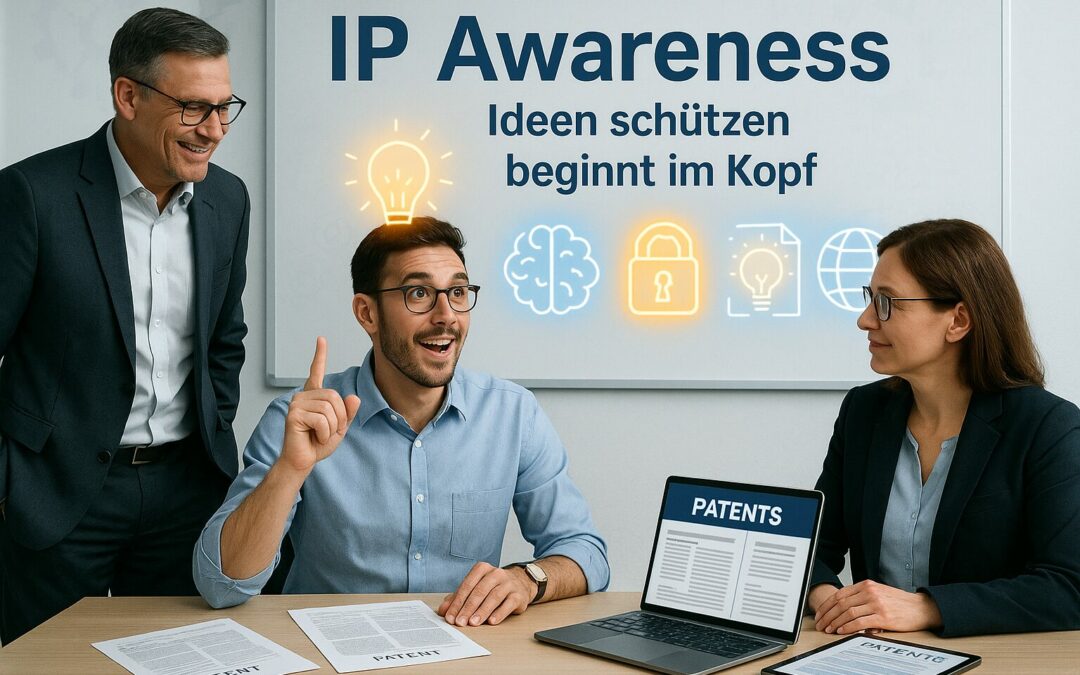
Preventing patent infringement: A guide for SMEs
1. Avoid patent infringements:
Why the topic is also important for SMEs
“We just wanted to develop a new nozzle.”
Many stories sound like this or something similar when small and medium-sized enterprises (SMEs) are suddenly confronted with the accusation of patent infringement .
The product was innovative, the developers were motivated, the market launch was within reach – but then a letter fluttered into the house.
Warning. Omission. License Demand. In the worst case, even a sales stop.
“But we developed it ourselves!” – Why that’s often not enough
Many SMEs assume that it is sufficient if an idea has been developed by themselves .
However, patent law does not protect who thinks something first, but who applies for it first.
And this protection has a negative effect: it prohibits third parties from using it – even if they come to the same solution independently.
This is precisely why the topic of patent infringement is not only relevant for corporations.
SMEs, start-ups and specialised niche providers can also be affected – because they:
operate in highly specialized markets,
are considered suppliers of innovative components ,
or simply want to keep up with the competition.
No reason to panic – but for clarity
The good news is that patent infringements can be avoided in many cases.
And without having to become a patent attorney right away.
What is needed are a few clear principles of thought, some systemic awareness – and the courage to address the topic in the team at an early stage.
This guide is for you if you:
make decisions in development, purchasing or management ,
work with innovation but have had little contact with intellectual property rights,
or simply want to avoid getting into a legal gray area.
You will get an overview that is practical, understandable and immediately applicable .
No forest of paragraphs – but orientation in everyday life.
Mini-Case: When the spare part became a tripping hazard
A medium-sized mechanical engineering company had developed a new type of spare part that was supposed to significantly extend the service life of a component.
The solution had been developed independently, but was based on a well-known operating principle – one that had already been patented .
No one on the team had ever thought about whether this feature might already be protected .
The part went into series production. Three months later, the warning came: a competitor had discovered the infringement of his patent.
Result: Compensation payment, recall, reputational damage.
What would the company do differently today?
A simple search – and a short conversation with an expert – would have been enough to identify the risk.
2. What is patent infringement – simply explained
When we talk about patent infringement , it quickly sounds like law, court and million-dollar lawsuits.
But at its core, it is about something very concrete: someone uses a technical solution for which someone else has an exclusive right – the patent.
Patents are like invisible fences
A patent is a prohibition right.
It does not allow the owner to produce himself – but it does allow him to prohibit others from using the protected invention without permission.
And this is true even if the other has developed the same idea independently .
This means:
Even those who work honestly and think innovatively can accidentally commit a patent infringement.
Not because he copied something – but because the legal rules of the game were not observed.
What exactly must not be violated?
It is not “the idea” itself that is specifically protected, but the technical design as described in the patent claims . These are the sections in the patent that determine exactly what is protected – and what is not. It is also called the “protection area“.
This leads to two important points for SMEs:
It is not enough to read the title page of a patent.
- It is not enough to read the introduction and come to the conclusion “But we are doing something completely different”, “We have a completely different goal” or “We are using it for something completely different”.
And it is also not enough to change the product slightly – if all the points of the patent claim are still met.
Patent infringements often happen unintentionally
Many companies infringe patents without knowing it.
Typical cases are:
Development of a new component, an improvement or a process without checking whether there are patents that protect exactly that.
- Purchase of assemblies or software without testing,
Adoption of technical standards that are protected by patents,
or reverse engineering competing products where parts are protected.
In all these cases, a company can unintentionally slip into a patent infringement – and will be held liable for it, even if there was no bad intention.
3. Avoid patent infringements – what you can do specifically
The good news first:
You don’t have to be patent law experts to effectively avoid patent infringements in the company.
What is needed is a clear view of typical risk points – and a few simple measures that fit well into your everyday life.
Think about patents from the beginning – not just at the end
Patent infringements often occur because technology and law run side by side.
That’s why the most important step is to ask the right questions early on – preferably already in the concept phase.
Here are a few guiding questions that can help you:
What exactly are we doing here technically – and is it perhaps already protected?
What function is at the core of our innovation?
Is this a solution that others could have come up with – and that someone has protected?
Where do the components we use come from – are they patent-free?
Who in our company has experience with such questions – or knows someone who can help?
These questions alone give you a better sense of risks – without having to delve deep into patent law.
Build yourself a simple IP radar
You don’t need your own patent department to establish an early warning system.
The only important thing is that IP (Intellectual Property) must not remain invisible.
A few ideas on how to do it:
Designates a person responsible for IP issues – as a point of contact
Use short IP checks during product development – e.g. as a question in the project form or simple checklists or approval fields as a reminder
Bring in an external expert at an early stage for new technologies
In this way, IP becomes an integral part of your innovation processes – not an additional bureaucratic monster.
When working with external parties, pay attention to clear agreements
A common trigger for patent infringement is cooperation with:
suppliers,
freelancers,
or external development offices.
Address the topic of patents openly – not only in the event of a dispute.
In contracts and briefings, you should clearly regulate:
Who is liable if a solution infringes patents?
Who checks whether the technologies used can be used freely?
Who owns the rights when something new is created together?
If there is clarity here, you will avoid many typical pitfalls.
Start small – effect follows
You don’t have to turn everything upside down right away.
A first small step can be:
an IP check in a new project,
a short conversation with a patent attorney,
or a mini-training with the team: “How do you actually recognize a patent?”
The goal is not perfection, but attention.
And those who identify risks early on can deal with them confidently – without hectic and without panic.
4. Patent search: How to find out if your idea is already protected
Before you invest a lot of time and money in a technical development, it’s worth doing a quick reality check:
Does your idea already have a patent?
This question is crucial – and the good news is: You can answer it yourself.
Patent search is not rocket science
Many believe that a patent search is something for specialists with expensive software and years of experience.
That’s not true.
With a little practice, you can do your own initial research – free of charge and quite reliably.
There are two central tools for this:
DEPATISnet – the patent register of the German Patent and Trade Mark Office
Espacenet – the European Patent Office’s international database
Both are accessible free of charge and offer a good start. I like to recommend Espacenet, because the database including the search mask is better structured and offers more possibilities. In addition, the European Patent Office has integrated patents from many major patent offices, so that the search is not limited to European patents. DEPATISnet can be used well for searches for purely German patents.
What exactly should you be looking for?
Focus on what really makes your technical solution special:
What problem does it solve?
What is the central technical idea?
Which technical terms describe them best?
Then you search specifically for these terms.
An example:
If you have developed a new type of connection mechanism, look for terms such as “coupling”, “locking system”, “connection mechanism” – combined with your field of application.
What you can learn from the hits
You don’t have to legally penetrate patent claims.
Instead, look at these three things:
Title and summary – What is the content about? Does this sound similar to your idea?
Applicants and inventors – who is behind it? Is it a competitor?
Legal status – Is the patent still in force, expired or has it been withdrawn?
This will give you a first feeling for whether your idea is really new and freely usable – or whether there are risks.
When is it enough to do your own research – and when not?
Simple research is a very good start, especially for smaller development projects or preliminary considerations.
However, it does not always replace in-depth testing by professionals – especially not if:
the project requires a major investment,
the product is ready for series production,
or a legally reliable result is needed (e.g. in the case of investors or licensing issues).
Then a freedom-to-operate analysis (FTO) by a specialized team is worthwhile.
Mini-Case: The blind spot in Asia
In one project, I worked with a medium-sized company that had not previously conducted Freedom-to-Operate (FTO) research .
They knew the usual competitors in German-speaking and European countries – maybe one or two players in the USA. But that’s it.
When we went deeper together and did systematic research for the first time, the surprise came:
Especially in the Asian region – especially in China – there were numerous IP applications for exactly the technologies on which this company was working.
Not only from large corporations, but also from universities, research institutes and small technology companies that were completely unknown in this country.
This was a real eye-opener for the team.
It became clear that there was a blind spot as far as the global IP context was concerned – especially in the Asian region. And thus also underestimated a considerable risk.
This experience was the trigger for a cultural change in the company:
Since then, an FTO check has been part of product development at an early stage – not as a compulsory exercise, but as a normal part of risk management.
My observation:
This blind spot is common in many SMEs – especially if their own market has previously felt more “European”.
But patents know no national borders – and there is pressure to innovate worldwide.
Reflection question for your team:
In which regions do we regularly look for patents – and where do we not (yet) look?
What would happen if someone was working on our idea there and had a patent on it?
5. What to do if you receive a warning letter for patent infringement?
As much as you want to avoid it – it can still happen:
A warning lands on the table. The accusation: patent infringement.
Now it is important that you remain objective, do not make hasty decisions and take the right steps .
Keep calm – don’t ignore it, don’t panic
A patent warning is not a guilty verdict, but a legal means by which a patent owner wants to assert his rights.
You don’t have to sign right now, you don’t have to promise anything hastily – but you can’t just ignore the matter either.
Because: If you don’t react, you risk injunctions or legal proceedings.
That’s why it’s important to keep a cool head – and proceed in a structured way.
The 5 first steps when you get a warning
Have a warning checked – professionally
Pass the letter on to a patent attorney immediately.
It is not only about the tone of the letter, but above all about whether the alleged violation exists at all.Document product and development
Record how you came to your solution. Are there drawings, e-mails, test reports? This can help clarify your position.Don’t react hastily
Not issuing cease-and-desist declarations without consulting a lawyer, not making any changes to the product – this can be legally disadvantageous.Analyze technical details
Is your product really protected by the patent?
Sometimes the solution is technically similar – but legally uncritical.Check options
Maybe a license is possible, maybe the product can be adapted, or the patent is no longer legally binding.
Good advice shows you the room for manoeuvre.
What you can learn from a warning
Even if it is unpleasant: A warning can be a valuable wake-up call.
Many companies are using this moment to question their processes:
Do we have a structured patent risk analysis?
How well are our suppliers protected?
Who is responsible for patents in our project?
It is worthwhile not only to “put out the fire” here, but to become more forward-looking in the long term.
6. Strengthen IP awareness in the company
– with simple means
Many patent infringements do not occur because someone acts carelessly or negligently.
But because the issue of patent protection is simply not taken into account.
It is not part of the routines, not part of the language – and often not part of the culture of responsibility.
Therefore, the central question is:
How can you ensure that patents become visible, understandable and discussable in the team – without training overkill?
Technical understanding is there – turns it into IP competence
Technical know-how is particularly high in development and production teams.
What is often lacking is not knowledge, but the impulse to legally classify this knowledge.
Therefore, it is worthwhile:
a common look at real patents that are close to your own products
the reading and understanding of patent claims – not legally, but technically
the exchange of questions such as:
– “What could be protected by it?”
– “What am I not allowed to copy about it?”
– “How would I get around that?”
This raises awareness – and activates the team.
IP knowledge: Someone should be able to do it – it’s better if everyone understands it
In every company, there should be at least one person who has actively dealt with the topic of patents – for example, through targeted training or further education.
This person can take on a kind of “memory role” :
It ensures that patents are taken into account in projects, asks questions, provides impetus – without blocking the process.
It is even more effective if all developers have a solid basic knowledge .
This is because it is often the developer himself who first realises that a solution is “close to the patent”.
If he or she then knows what that means and where you can look or ask, real self-efficacy develops in the team.
IP doesn’t need a flood of PowerPoint – just a place in everyday life
Instead of large, constant training, small, targeted measures often have a long-term effect:
IP Question of the Month on the Whiteboard or in Project Meeting
Mini-case studies from the industry (with a short aha effect)
Short video impulses or one-pagers with typical errors
Open rounds in which questions can be asked – without evaluation
This creates an environment in which IP does not “come from the outside”, but becomes part of one’s own thinking.
Responsibility instead of control
IP awareness works well when it is not confused with control.
It’s not about looking for mistakes – it’s about strengthening the ability to act.
For example, ask yourself the following questions as a team:
Would we have developed this function without looking at intellectual property rights?
Would we decide differently if we knew more about patents?
Where do we see blind spots today – in the market, in technology, in our processes?
IP knowledge does not mean knowing everything – but being able to ask the right questions.
7. Conclusion: Prevention is easier than you think
At first glance, patent infringements seem like a special topic – technical, legal, complicated.
But on closer inspection, it’s about something very practical:
How do you ensure that your innovation work does not accidentally come into conflict?
Most injuries do not happen on purpose, but because of blind spots:
Because no one knew that there was already a patent.
Because no one asked whether the purchased module was legally clean.
Because no one was responsible.
And that’s exactly where the lever lies:
If you clearly distribute responsibility, build a basic understanding of patents and weave simple checks into your processes, you can avoid most risks – before they arise.
The three most important principles to take away:
Thinking along instead of thinking
→ Think about patents at an early stage – not just at the product launch.Questions instead of silence
→ Better to ask too many questions than to research too little.Responsibility instead of control
→ Creates a culture where IP is seen as part of good development work – not as outside bureaucracy.
Encouragement at the end
You don’t have to be patent lawyers.
But if you want to continue to work innovatively as an SME, then a confident handling of intellectual property rights is simply part of it.
Start small. Choose an entry that suits you.
And make patents a part of your thinking and working culture.
Not as an obstacle – but as a playing field with clear rules.


